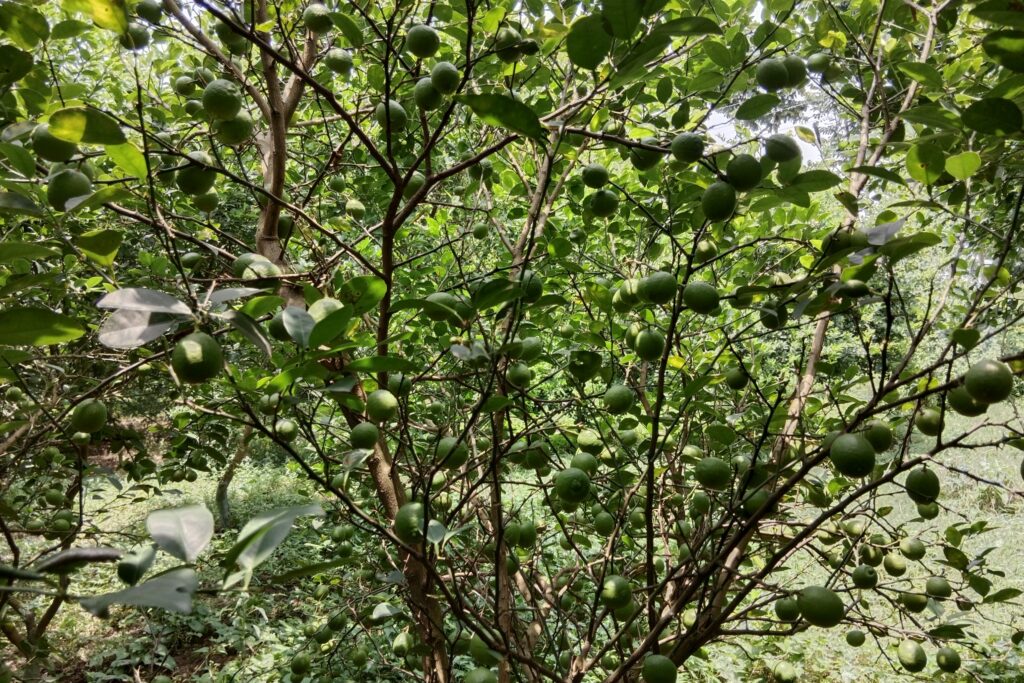Lemon Flower
Lemon (Citrus limon Burm.) is one of the most widely consumed fruits and is grown effectively everywhere in the world. As polycarpic and evergreen, the trees usually flower once in the spring or several times a year, depending on temperature and genetics.
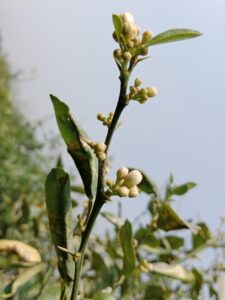
It has three main flowering flushes: spring, summer, and autumn. The main crop is produced during the spring flush, while the remaining flowering flushes are dispersed over the summer and fall seasons. However, the fruit produced from spring flush may have a fruit cracking problem which is probably a physiological disorder.
It is important to understand citrus flowering mechanisms since they signal the beginning of the reproductive phase. A deeper understanding of these mechanisms is necessary to improve control over the schedule of crop yields and the efficiency of production. Plants bloom in response to several environmental signals, including photoperiod, low temperatures, plant water stress, and their combinations.
The onset of lemon flower is triggered by cooler temperatures and water scarcity stress, occurring 2–3 months before bud sprouting, simultaneous to differentiation. These induced buds develop solitary flowers or clusters, ensuring recurrent fruiting.
To sustain this habit, promoting vegetative growth in the axillary buds is essential. Additionally, existing fruits inhibit sprouting and lemon flower initiation in nearby axillary buds during the current season. Managing these aspects before the flowering phase is crucial for ensuring optimal growth and a plentiful lemon yield.
A tree can produce approximately 250,000 flowers at its peak, but usually, fewer than 1% of these flowers develop into fruits. Different species and cultivated types exhibit blooming either once or multiple times each year.
Therefore, ensuring optimal care before and after flowering is essential to achieve maximum bloom for lemon flowers. Following the fruit set, lemon flowers yield round-shaped fruits with a greenish-yellow hue, consistently throughout the year.
The types of lemon flowering branch
The flowering branch in lemon may be either a mixed branch or a generative branch.
Mixed flowering branch
Leafy inflorescences with many single axillary flowers or a single terminal flower on short leafy branches make up mixed shoots.
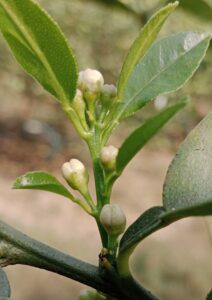
Generative flowering branch
Condensed cymose inflorescences with one or more flowers and no leaf development make up generative flowering branches. Generative flowering branches yield a higher percentage of flowers than mixed flowering branches in the case of lemon flowers.

Both generative and mixed branches develop and anthesis first in the terminal flower, and the number of days with temperatures above 12.8˚ C is closely proportional to the rate with which inflorescence shoots develop.
When do lemon trees flower?
It is late winter (February) and spring (March) when lemon trees usually flower. However, the exact date may vary based on the variety of lemon trees, the local climate, and other environmental factors. In Mediterranean climates, where lemon trees are widely planted, late winter to early spring is when they flower.
The flowering of lemon trees is influenced by several factors, including temperature, day length (photoperiod), and the tree’s age and health. It’s worth noting that lemon trees may produce flowers and fruit multiple times a year, especially in regions with a mild climate. However, the primary flowering season is typically in the spring. Additionally, some lemon varieties may exhibit variations in their flowering patterns.
To optimize the flowering and fruiting of lemon trees, it’s essential to provide them with appropriate care, including well-drained soil, sufficient water, and adequate nutrients. Regular pruning and the removal of dead or damaged branches can also contribute to a healthier and more productive lemon tree.
Care Tips Before Lemon Flowering
To get heavy flowering on the tree, take care of the following things before lemon flowering:
Avoid Overfeeding with Fertilizers
While nutrients are crucial for the growth of plants, excessive feeding can negatively impact your lemon tree. Before flowering, it’s important to avoid over-fertilizing, as this can disrupt the nutrient balance, impede flower production, and harm the tree’s roots. Stick to a balanced fertilizer specifically designed for citrus plants, and carefully follow the recommended guidelines.
An excess of nitrogen, in particular, can stimulate excessive growth of leaves, taking away from the formation of flowers. Overfed lemon trees might display reduced flowering or a complete absence of flowers. This happens because the tree prioritizes leaf growth over reproductive development. Flowers play a pivotal role in fruit production, so a lack of flowering can result in a poor fruit yield or no fruits at all. Therefore, it’s essential to maintain a balanced fertilization approach to ensure proper growth and fruit production in lemon trees.
Avoid Heavily Pruning
Trimming lemon trees is advantageous for maintaining their shape, eliminating dead branches, and fostering robust growth. However, excessive pruning before flowering can deplete the plant’s energy reserves, impacting its capacity to produce flowers. It’s advisable to refrain from overly aggressive pruning at this critical stage, opting instead for gentle trimming with pruning shear and eliminating the damaged or diseased sections.

Pruning lemons should aim to open up the tree’s canopy, thwarting fungal diseases, but excessive pruning can hinder blooming. It’s crucial never to remove more than a third of the tree’s greenery during pruning. This practice strikes a balance: it allows the plant to conserve energy for blooming while enhancing airflow within the canopy. This cautious approach to pruning ensures the lemon tree’s health and encourages optimal flowering and fruit production.
Removal of Flowering Wood
Lemon trees produce flowers and fruits on the previous season’s growth. Heavy pruning often involves cutting back a significant portion of the tree’s branches, including those that might have developed flower buds or potential fruiting wood. When this growth is removed, the tree loses the sites where flowers and subsequent fruits would have emerged, resulting in reduced flowering.
Shock and Stress
Pruning causes stress to plants as it involves cutting away branches and foliage. This stress can temporarily halt or delay flowering as the tree redirects its energy towards recovering from the pruning rather than investing in flower and fruit production. The more severe the pruning, the longer it may take for the tree to recover and resume its normal flowering cycle.
Disturbed Growth Cycle
Lemon trees have a specific growth cycle. Heavy pruning can disrupt this natural cycle, causing the tree to focus on regrowth rather than flowering. The tree may need time to re-establish its balance and energy reserves before it can allocate resources to flowering and fruiting.
Loss of Hormonal Balance
Pruning affects the hormonal balance within the tree. Some hormones are responsible for bud development and flowering. Heavy pruning can interfere with this hormonal balance, potentially inhibiting the formation of flower buds or reducing the tree’s capacity to produce flowers.
Reduced Photosynthetic Capacity
Pruning reduces the overall leaf surface area available for photosynthesis. Since photosynthesis is crucial to producing energy and carbohydrates necessary for flower and fruit development, heavy pruning can limit the tree’s ability to generate enough energy to support flowering.
To mitigate the negative effects of heavy pruning on lemon flowering:
Prune strategically
Avoid heavy pruning during periods when the tree is expected to flower or set fruit.
Gradual pruning
Spread pruning over time instead of performing severe cuts all at once to minimize shock and stress to the tree.
Prune at the right time
Pruning at the correct time of the year, typically after fruiting, allows the tree more time to recover and initiate new growth before the flowering season.
Avoid Overwatering or irregular watering
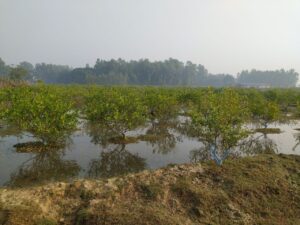
Maintaining proper hydration for your lemon plant is crucial, yet overwatering or erratic watering methods can be harmful. Before flowering, guarantee the soil has efficient drainage to prevent waterlogging, which can lead to root rot and impede flower development. Conversely, avoid letting the soil completely dry out, as consistent moisture is essential for fostering healthy growth in the lemon plant.
Avoid Sudden Changes in Environmental Conditions
Lemon trees can be affected by sudden changes in their surroundings. To ready the plant for flowering, steer clear of abruptly moving it to vastly different conditions. Quick variations in temperature, light exposure, or humidity levels might stress the plant, impacting its capacity to bloom. If there’s a need for a change, slowly introduce the plant to the new environment, allowing it to adapt gradually for a smoother adjustment.
Do Not Allow Pests and Diseases to Thrive
Pests and diseases pose significant threats to a lemon tree, especially as it approaches the flowering stage. Neglecting proper pest control practices should be avoided. It’s crucial to consistently check the plant for any indications of pests or diseases and promptly apply suitable remedies to tackle any problems. Prioritizing prevention plays a vital role in guaranteeing a healthy and successful flowering season for the lemon tree.
Care Tips After Lemon Flowering
Care for the following:
Control Citrus Canker

A bacterial disease known as citrus canker damages citrus trees. Citrus canker mainly affects the little fruitlets, especially in the first ninety days after the petals fall off the blossoms.
Management
To prevent citrus canker during this critical period, it is recommended to apply 3–4 sprays at intervals of 15-20 days. These sprays likely contain specific fungicides or bactericides effective against citrus canker. Regular applications aim to create a protective barrier, reducing the risk of infection.
Control Fruit Drop
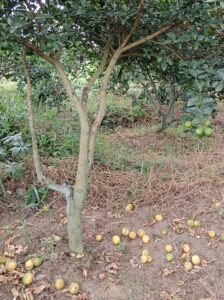
Zinc Sulfate and Borax Application
Protein biosynthesis, nucleic acid metabolism, and photosynthesis are all improved in plants with adequate zinc levels. When boric acid and zinc sulfate are sprayed combinedly during fruit set, more boron and zinc are found in the leaves, which promotes fruit quality, productivity, and growth.
Optimal plant yield arises from higher zinc and lower boron concentrations. Elevated zinc decreases flowering-to-harvest intervals, enhancing fruit set, count, volume, weight, and yield. Zinc’s role in tryptophan synthesis increases fruit numbers and prevents fruit drop.
Applying micronutrients promotes growth, fruit size, and overall production while decreasing drop and increasing flowering, fruit set, and quality. In addition, the application of zinc helps in nitrogen uptake.
During late spring, summer, or fall, foliar zinc fertilizer is usually used in conjunction with other micronutrients and pesticide applications.
Regular Watering
Frequency
Advises watering 1-2 times, indicating a moderate watering schedule.
Monitoring Soil Moisture
It recommends applying water when the soil is dry about 2 inches below the surface. This implies that the moisture level in the root zone should be monitored to ensure it doesn’t become overly dry.
Caution Against Overwatering
Warns against overwatering, which can lead to root rot. Overly wet conditions can create an environment conducive to the growth of pathogens that cause root diseases.
Pruning and Thinning
Pruning Dead or Damaged Branches
Encourages the removal of dead, diseased, and damaged branches through pruning. This practice helps maintain tree health and prevents the spread of diseases.
Thinning Overcrowded Branches
Trimming back branches that are too dense to improve the general health of the tree, higher air circulation, and higher light penetration result from this strategy, which promotes new growth.
Fruit Color Enhancement
Points out that proper pruning and thinning contribute to good fruit color by ensuring that light can penetrate the tree canopy effectively.
Fertilizer Application
Recommends applying the recommended dose of fertilizers in late February (1st dose) and in June (2nd dose). This timing coincides with the periods of increased nutrient demand, supporting healthy growth and fruit development.
Spray against Leaf miner
Biological Control
Suggests that citrus leaf miners can be controlled by parasitic wasps. This is an example of biological pest control, where natural predators are employed to manage pest populations.
Systemic Insecticides
For better control of citrus leaf miners, systemic insecticides (thiamethoxam, imidacloprid) should be used instead of contact insecticides. Longer-lasting protection is offered by systemic insecticides, which are absorbed by the plant.
These recommendations collectively form a comprehensive guide for the care and management of citrus trees, addressing issues related to diseases, pests, watering, pruning, and fertilization.
Factors Affecting Lemon Flowering
Several factors influence the flowering of lemon trees. Understanding these factors is crucial for optimizing the conditions that promote flowering. Here are some key factors:
Age of the Tree
Maturity
Lemon trees generally start flowering when they reach a certain level of maturity. Young trees may take a few years to reach reproductive maturity and produce significant blooms.
Environmental Conditions
Temperature
Lemon trees thrive in warm climates. The initiation of flowering is often triggered by warmer temperatures. Frost or cold conditions can negatively impact flowering and fruit sets.
Photoperiod (Day Length)
The duration of daylight also plays a role. Lemon trees often respond to changes in day length, with spring’s increasing daylight hours being a common trigger for flowering.
Nutrient Availability
Fertilization: Adequate nutrient availability, especially nitrogen, phosphorus, and potassium, is essential for healthy growth and flowering. A balanced fertilizer application can positively impact flowering.
Pruning Practices
Timing and Severity
If done properly, pruning can encourage flowering and new growth. On the other hand, too much or too little trimming might prevent or limit flowering.
Watering Practices
Consistent Moisture
Lemon trees prefer consistent moisture, especially during flowering and fruit development. Inconsistent watering or drought stress can lead to flower drops or poor fruit development.
Pest and Disease Management
Health of the Tree
Healthy trees are more likely to flower abundantly. Pest infestations or diseases can stress the tree and inhibit flowering. Proper pest and disease management are essential.
Genetic Factors and Variety
Tree Variety
Different lemon varieties may have varying flowering habits. Some varieties may naturally flower more prolifically than others.
Genetic Predisposition
The genetic makeup of the tree influences its flowering behavior. Some trees may have genetic tendencies to flower under certain conditions.
Previous Fruit Load
Alternate Bearing
Lemon trees, like many fruit trees, may exhibit a pattern known as alternate bearing, where the tree produces a heavy crop one year and a lighter one the next. Managing fruit load can influence flowering in subsequent seasons.
Soil Conditions
Well-Drained Soil
Lemon trees prefer well-drained soil. Waterlogged or poorly drained soil can lead to root issues that affect overall tree health and flowering.
Weather Events
Unfavorable Weather
Extreme weather events, such as unseasonal frosts, can damage flowers and impact fruit sets. Consistent, mild weather during the flowering period is ideal.
Understanding and managing these factors can contribute to a healthy lemon tree with consistent and abundant flowering. Adjusting cultural practices based on these considerations helps create optimal conditions for lemon trees to thrive and produce quality fruit.
Conclusion
The journey of a lemon plant from budding to blossoming requires patience, care, and the avoidance of certain practices that can hinder its growth. By refraining from over-fertilizing, excessive pruning, erratic watering, abrupt environmental changes, and neglecting pest control, you can create optimal conditions for your lemon plant to flourish and produce an abundance of fragrant blossoms and delicious fruits.
Remember, every step taken to care for your lemon plant before flowering contributes significantly to its overall health and productivity, rewarding you with a thriving and fruitful tree in the seasons to come.
FAQs
Q1. How long does it take a lemon to grow from a flower?
The time it takes for a lemon flower to develop into a mature fruit is approximately 165-180 days after full bloom. After successful pollination, the flower transforms into a small green fruit, and over the months, it undergoes a gradual ripening process. Adequate sunlight, proper watering, and nutrient availability contribute to a faster and healthier fruit development process. Generally, lemons reach harvest maturity when they achieve a characteristic color, size, and firmness, signaling the optimal time for picking, usually within the specified time frame.
Q2. Why does my lemon tree flower but no fruit?
There are various reasons why a lemon tree that is in flower doesn’t produce fruit. A lack of nutrients, inadequate pollination, or environmental stress are some causes. Inadequate pollination can impede fruit growth; this is frequently caused by a deficiency of pollinators or unfavorable weather during the flowering season. Lemon flower drops may result from environmental stressors like intense heat or erratic watering. Inadequate nutrition can also affect fruit setting; this is especially true of potassium and phosphorus. To overcome this problem, create a favorable atmosphere, encourage pollination, provide regular maintenance, and think about fertilizing with a balanced mixture to aid in fruit creation.
Q3. Why did my lemon tree stop flowering?
Several factors can contribute to a lemon tree ceasing to flower:
Environmental Stress
Extreme conditions like temperature fluctuations or drought can cause the lemon tree to stop flowering.
Nutrient Deficiency
Insufficient phosphorus and potassium may impede the tree’s reproductive processes, affecting flowering.
Pruning Practices
Excessive or mistimed pruning can remove flower buds, disrupting the natural flowering cycle.
Poor Pollination
Reduced fruit sets may arise from inadequate pollination brought on by a deficiency of pollinators or adverse weather.
Age of the Tree
Young trees may not flower abundantly until reaching maturity, and older trees may experience natural fluctuations in flowering.
Disease or Pests
Infections or infestations can stress the tree, leading to a decline in flowering.
Seasonal Variations
Lemon trees have natural flowering cycles, and seasonal variations can affect the abundance of flowers.


